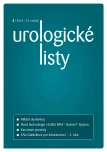SEXUAL FUNCTION AFTER TRANSURETHRAL RESECTION OF THE PROSTATE
Authors:
M. Ghazal
Authors‘ workplace:
Urologická klinika LF MU a FN Brno
Published in:
Urol List 2015; 13(3): 32-34
Overview
Benign prostatic hyperplasia is commonly seen in elderly men. Benign prostatic hyperplasia often presents as lower urinary tract symptoms due to difficulties in voiding and irritability of the bladder. Recent evidence from clinical trials has suggested a link between benign prostatic hyperplasia/lower urinary tract symptoms and erectile function. Transurethral resection of the prostate has been considered the standart treatment for benign prostatic hyperplasia for the past 30 years. However, it is reported to cause erectile dysfunction, although some patients with preexisting erectile dysfunction reported improved erectile function after transurethral resection of the prostate. The aim of this study was to evaluate erectile function after transurethral resection of the prostate institution using the International Index of Erectile Function questionnaire.
Key words:
erectile dysfunctionbenign prostatic hyperplasia IIEF questionnaire
Sources
1. Burnett AL, Aus G, Canby - Hagino ED et al. Erectile function outcome reporting after clinically localized prostate cancertreatment. J Urol 2007; 178(2): 597–601.
2. Penson DF, McLerran D, Feng Z et al. 5-year urinary and sexual outcomes after radical prostatectomy: results from the Prostate Cancer Outcomes Study. J Urol 2008; 179 (Suppl 5): S40–S44. doi: 10.1016/j.juro.2008.03.136.
3. Ayta IA, McKinlay JB, Krane RJ. The likely worldwide increase in erectile dysfunction between 1995 and 2025 and some possible policy consequences. BJU Int 1999; 84(1): 50–56.
4. Gales BJ, Gales MA. Phosphodiesterase-5 inhibitors for lower urinary tract symptoms in men. Ann Pharmacother 2008; 42(1): 111–115.
5. Arrighi HM, Metter EJ, Guess HA et al. Natural history of benign prostatic hyperplasia and risk of prostatectomy. The Baltimore Longitudinal Study of Aging. Urology 1991; 38 (Suppl 1): 4–8.
6. Chute CG, Panser LA, Girman CJ et al. The prevalence of prostatism: a population based survey of urinary symptoms. J Urol 1993; 150(1): 85–89.
7. Feldman HA, Goldstein I, Hatzichristou DG et al. Impotence and its medical and psychosocial correlates: results of the Massachusetts Male Aging Study. J Urol 1994; 151(1): 54–61.
8. Ledda A. Cigarette smoking, hypertension and erectile dysfunction. Curr Med Res Opin 2000; 16 (Suppl 1): S13–S16.
9. Lue TF, Tanagho EA. Physiology of erection and pharmacological management of impotence. J Urol 1987; 137(5): 829–836.
10. Hanbury DC, Sethia KK. Erectile function follow-ing transurethral prostatectomy. Br J Urol 1995; 75(1): 12–13.
11. Poulakis V, Ferakis N, Witzsch U et al. Erectile dysfunction after transurethral prostatectomy for lower urinary tract symptoms: results from a center with over 500 patients. Asian J Androl 2006; 8(1): 69–74.
12. Oh SY, Min KS, Choi SH. Effects of prostate volume and lower urinary tract symptoms on erectile function. Korean J Urol 2007; 48(1): 24–28. doi: 10.4111/kju.2007.48.1.24.
Labels
Paediatric urologist UrologyArticle was published in
Urological Journal

2015 Issue 3
Most read in this issue
- Selective estrogen receptor modulators and the management of male hypoandrogenism – a systematic analysis
- CURRENT MANAGEMENT OF ADULT NEUROGENIC BLADDER – A REVIEW
- “THE REZŪM™ SYSTEM” TECHNOLOGY IN THE TREATMENT OF BPH – MEDIUM-TERM CLINICAL OUTCOMES
- SEXUAL FUNCTION AFTER TRANSURETHRAL RESECTION OF THE PROSTATE
